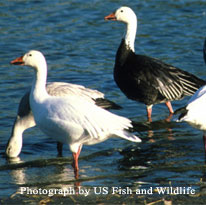Wildlife - Species

Species Specific Regulations
Snow Geese
Licenses: Hunting License required. Migratory Bird Hunting and Conservation Stamp (Federal Duck Stamp) that is validated by the hunter signing the stamp in ink across the face of the stamp
Limits: Please see Migratory Bird Regulations for any game zones restrictions or Limitations.
Snow Geese (Chen caerulescens)

Description
Snow geese occur in 2 morphs: white and dark. The more common white morph is white all over with black wingtips and a pink bill. The dark morph is also referred to as the "blue goose" because it has a white face with a dark brown body, and white underneath the tail.
Average Size
Snow geese have an average length of 29-31 inches and an average weight of 6 1/2 - 7 1/2 pounds.
Range
Snow geese are found in all 4 flyways but are most common in the Atlantic and the Mississippi. Snow geese are unusual visitors to South Carolina in the winter months and have been spotted throughout the state but are most common along the coast.
Preferred Habitat
In the summer months snow geese are found in the subarctic and arctic tundra near the coast near ponds, shallow lakes, streams, or islands. In the winter months snow geese are found in estuarine marshes, marine inlets and bays, freshwater and brackish marshes and inland on wet grasslands, marshes, and cultivated fields.
Food Habits
Snow geese are predominately herbivorous, consuming a wide variety of seeds, stems, leaves, tubers, roots, sedges, aquatic plants, and grains. Snow geese are often found in agricultural crops.
Reproduction
The mated pair arrives on the breeding ground together. The female then selects a nesting site, often close to melted snow and areas of cover like rocks and small shrubs. The female creates a scrape in the ground and gradually adds leaves, grasses, and branches to the nest as she lays 2-6 creamy white eggs.
Sound
Loud nasal whouk or kow-luk.
Behavior
- Strong walker on land, spends most of its life on foot.
- Breeding pairs will actively defend area around nest in the colony.
- Colonial nesters, isolated nests are still common.
- Broods will flock together in loose groups of 20-100 families.
- Found in large flocks during the winter months.
Citations, Publications and Literature
U.S. Fish & Wildlife Service, Federal Duck Stamp Office Presents: North American Waterfowl (Adobe PDF file)
Mowbray, Thomas B., Fred Cooke and Barbara Ganter. 2000. Snow Goose (Chen caerulescens), The Birds of North America Online (A. Poole, Ed.). Ithaca: Cornell Lab of Ornithology; Retrieved from the Birds of North America Online
South Carolina waterfowl hunters 16 and older are required by state law to obtain a state migratory waterfowl permit and Migratory Game Bird permit. Both permits must be in the hunter's possession while hunting or transporting legal waterfowl. A state waterfowl permit is included with the Lifetime Senior, Lifetime Gratis and Disability Licenses. S.C. residents who hold a Lifetime Senior or Lifetime Gratis License are not required to have a Migratory Game Bird permit.
National Migratory Bird Harvest Information Program (HIP)
The waterfowl permits and HIP permits are available from select DNR offices and from hunting and fishing license agents.
